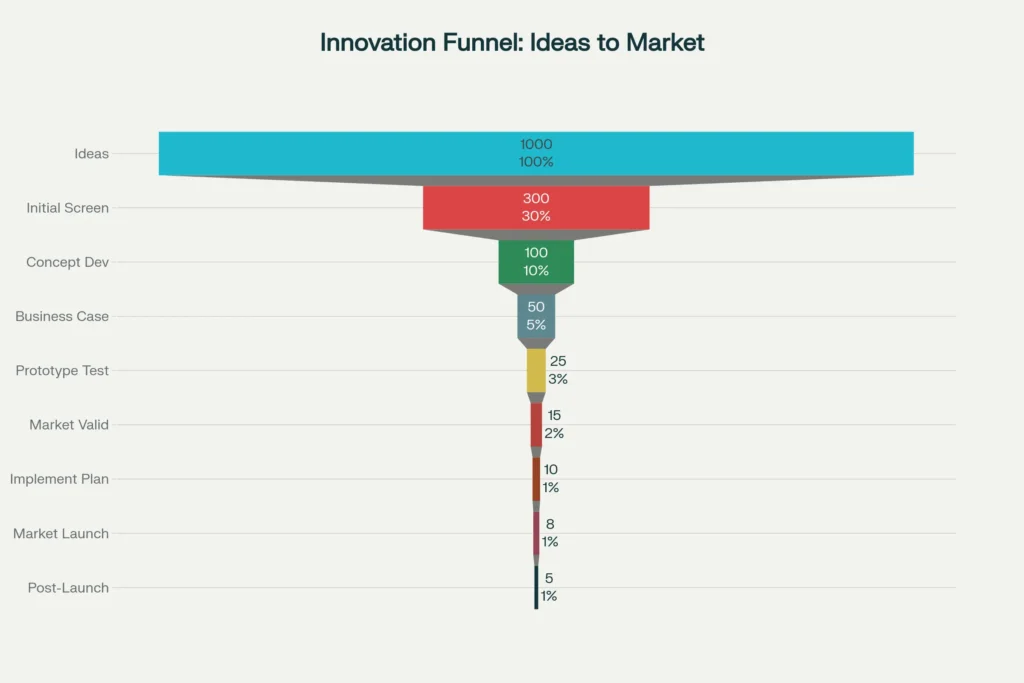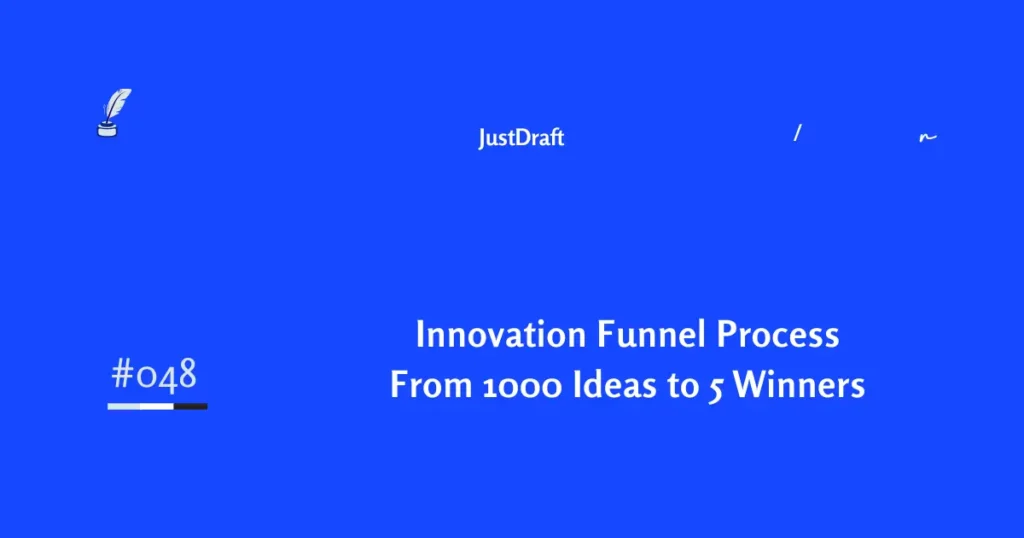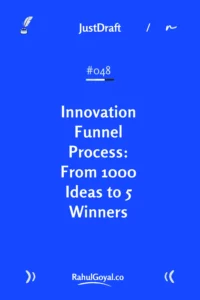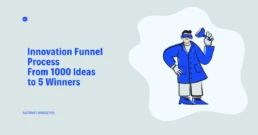How to Build an Innovation Funnel That Delivers Real Results
Most ideas sound crazy when you first hear them. Think about smartphones in the 90s, driverless cars a decade ago, or even online payments when cash was king. At the start, wild ideas rarely look practical. But when refined through structure and discipline, they can turn into world-changing solutions.
That’s where the innovation funnel comes in.
One Topic: The Innovation Funnel – From Wild Ideas to Practical Solutions
What is an Innovation Funnel?
Think of the innovation funnel as a gold mining operation. You start with tons of raw material (wild ideas), run it through progressive filters, and end up with pure gold (market-ready solutions).
Here’s the brutal reality: If you start with 1,000 ideas, maybe 5 will become market successes. That’s a 0.5% conversion rate.
Sounds depressing? Actually, it’s liberating.
Why Most Innovations Fail
The numbers are brutal: 75–85% of new products fail. In some industries, failure rates are even higher. Yet companies that use structured innovation funnels report 3x higher success rates. Stage-Gate methodology, for example, boosts success to nearly 78% compared to just 24% with unstructured approaches.
In simple terms:
structure beats chaos.
The Power of Wild Ideas
Let me share why “crazy” ideas matter.
Your team suggests teleportation for instant product delivery. Impossible, right? But that outrageous concept reveals something valuable – customers want immediate gratification. That insight led Amazon to same-day delivery.
Wild ideas work because they bypass your brain’s self-censorship. When you remove practical constraints initially, your team stops filtering ideas before they’re even spoken. This cognitive liberation unlocks breakthrough thinking.
The key is what happens next: you don’t implement the wild idea. You extract the core benefit and find practical ways to deliver similar value.
How the Innovation Funnel Actually Works
Let’s walk through the stages:
- Stage 1: Idea Generation (1,000 concepts) Cast a wide net. Encourage wild thinking. No filtering yet.
- Stage 2: Initial Screening (300 ideas) Quick filter for basic alignment with strategy and feasibility. Kill 70% fast.
- Stage 3: Concept Development (100 concepts) Develop remaining ideas into actual concepts with customer benefits defined.
- Stage 4: Business Case (50 concepts) Half survive detailed analysis of market potential, costs, and competition.
- Stage 5: Prototype (25 prototypes) Build and test. Another 50% prove unworkable.
- Stage 6: Market Validation (15 solutions) Customer testing reveals which solutions actually solve problems.
- Stage 7: Implementation Planning (10 approved projects) Detailed plans separate ready-to-launch from not-quite-there.
- Stage 8: Market Launch (8 products) Real-world introduction with full resources.
- Stage 9: Success (5 market winners) The final filter – actual market performance.

Notice the pattern? Each stage gets tougher. Each gate demands stronger evidence. This progressive refinement is what separates innovation theater from innovation results.
The funnel isn’t about generating ideas – it’s about filtering and refining them until only the strongest remain.
The Critical Success Factor: Gates with Teeth
Here’s where most companies fail: they create innovation funnels but can’t kill projects.
Every gate needs clear criteria and decision-makers who control resources. If projects keep moving forward regardless of results, you don’t have a funnel – you have a tunnel.
Best-in-class organisations make tough calls. They kill weak projects early, freeing resources for winners. This discipline feels harsh but delivers 300-500% ROI improvements within 24 months.
Recently, I heard Steven Bartlett mention something fascinating on his podcast – he has a dedicated team whose job is to organize experiments and test ideas. They even have a Head of Failure. The logic is simple: the more you fail, and the faster you fail, the better your chances of success. Each failure is a learning opportunity that moves you closer to what actually works.
Making It Work in Your Organisation
Start with these three moves:
- Get Cross-Functional Fast Innovation affects multiple departments. Don’t let engineering build what marketing can’t sell or operations can’t deliver. Build truly cross-functional teams from day one.
- Stay Customer-Obsessed The top predictor of innovation success? Delivering unique customer benefits with superior value. Keep customer voice active at every gate, not just at launch.
- Measure What Matters Track idea submission rates, stage conversion rates, time-to-market, and revenue from new products. What gets measured gets optimised.
The Modern Twist: Lean Meets Structured
The newest approach combines Stage-Gate discipline with lean startup speed.
Use gates for go/kill decisions and resource allocation. Use Build-Measure-Learn cycles between gates for rapid learning. This hybrid approach delivers both disciplined filtering and fast iteration.
Your Starting Point
You don’t need a perfect system on day one. Start here:
- Define 3-5 clear decision criteria for each major gate
- Assign decision-makers who actually control resources
- Track how many ideas enter and exit each stage
- Kill at least one project this quarter to prove gates work
- Celebrate the kills as much as the wins – both create value
Innovation isn’t about having the best ideas. It’s about having the best system to identify which ideas deserve resources and which need to die quickly.
The innovation funnel won’t make every wild idea work. But it will help you spot the 0.5% that should – and give them everything they need to succeed.
Because in the end, innovation success isn’t luck or genius. It’s system design.

Interested in travel, read last week’s LensLetter newsletter about Photography Skills No Camera Can Replace.
Read last week’s JustDraft about Change Fatigue.
Two Quotes to Inspire
Innovation isn’t about protecting every idea – it’s about killing the wrong ones fast enough to fully fund the right ones.
The mark of innovation maturity isn’t how many projects you start, but how many you have the courage to stop.
One Passage From My Bookshelf
The Lean Startup method is not about cost, it is about speed. By taking a learn–measure–build approach, startups can quickly test their vision, adjust, and adapt before it is too late. Instead of making long-term plans, they can adapt continuously. This constant feedback loop turns ideas into products more effectively than traditional planning. Innovation is not about predicting the future; it is about responding quickly to what is actually happening.
📚From From The Lean Startup by Eric Ries


